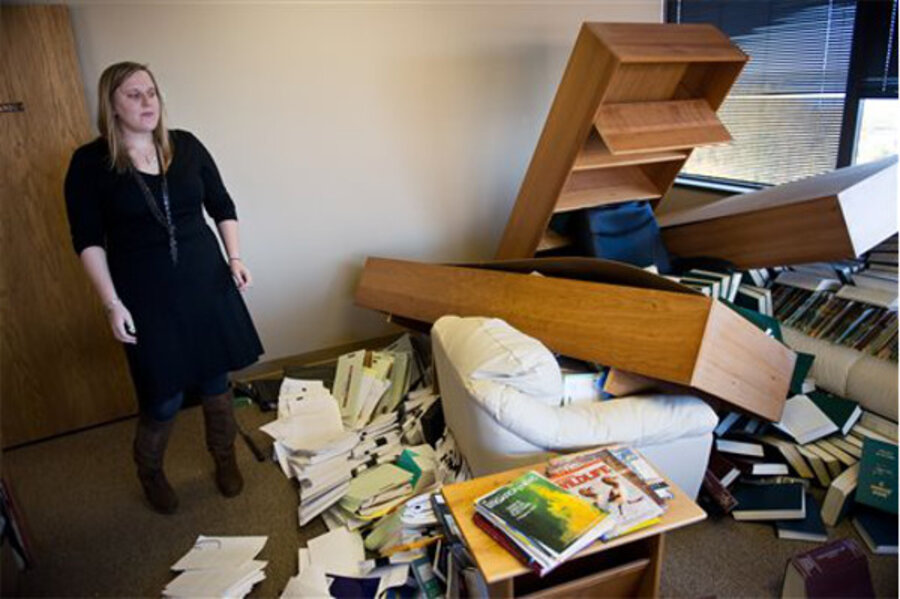Alaska earthquake: Powerful temblor rattles Anchorage
Loading...
| ANCHORAGE, Alaska
A powerful earthquake shook a large swath of Alaska on Thursday morning, knocking things off shelves and causing people to take cover but bringing no immediate reports of injuries or major damage.
The quake had a preliminary magnitude of 6.2, and it hit at 9:51 a.m. The epicenter was about 80 miles northwest of the state's largest city, where it was strongly felt, the Alaska Earthquake Center said. The quake lingered for at least a minute in some areas.
The earthquake center is in Fairbanks, 250 miles northeast of the epicenter, but it was felt, even there, said Sara Meyer, a center research technician.
"It was about 15 seconds of long-period shaking, sort of like you're on a boat," Meyer said.
Staffers at the Nesbett Courthouse in downtown Anchorage felt the shaking in their office on the top floor of the six-story building.
"My computer tower fell off my desk," judicial assistant Ellen Bozzini said. Everyone stood in doorways until an evacuation was ordered. Then they took the stairs outside, where they waited for about 20 minutes before being allowed back in the building.
There were no immediate reports of major damage or injury, and no tsunami was expected, according to an emergency management official. The fact that the earthquake's center was, according to the U.S. Geological Survey, about 63 miles underground softened its impact on the state, experts said.
Bryan Fisher, incident commander for the state emergency operations center, said the office has received scattered reports of things flying off shelves. But there have been no reports of any infrastructure damage.
The Alaska Railroad stopped all trains to check the tracks and bridges for damages, which is a procedure after earthquakes, Fischer said.
In the Matanuska-Susitna Borough north of Anchorage, closer to the epicenter, there were reports of books knocked off shelves but no serious damage, borough spokeswoman Patty Sullivan said.
"We all felt it," she said, adding she was sitting in her parked minivan when the quake happened. She believed someone was playing a joke on her and purposely shaking her van. "I got out, expecting to find a laughing face," she said.
In Willow, about 40 miles north of Anchorage, a clerk at the town's hardware and grocery store said everything shook but nothing fell off the shelves.
"Everything just rocked around," Anne Holliday said. "It's an old building, just rickety."
Debra Pearce, who works for Alaska Auction Company, said she has lived in Alaska for years and this was the strongest quake she felt since a 1964 temblor. That earthquake — a magnitude 9.2 — was the second-highest magnitude ever recorded, and the quake and resulting tsunamis killed 131 people.
"This was akin to that, the way it hit real hard and rolled and rolled and rolled and rolled, and you didn't know if it was just going to pick up or not," Pearce said.
Sandy Lee, who owns Sandy Espre Cafe in midtown Anchorage, said she didn't feel the earthquake as she was driving to work. When she got to her business, she didn't know what had happened. Coffee syrup bottles littered the floor, and dolls had fallen off of shelves.
Jill Warburton was shopping at a department store when the quake hit. She said things fell off shelves, but they didn't appear to be broken. When she got to her job at the Gold and Diamond Co. in midtown Anchorage, where she's a sales clerk, a few decorative plates had fallen on the ground.
Warburton shrugged off the quake. "I went through the one in '64 — this is nothing," she said.
The rumbling disturbed a news conference for U.S. Senate candidate Dan Sullivan, who was receiving formal support from the U.S. Chamber of Commerce, at the Beacon Occupational Health and Safety Services office in Anchorage.
In a disruption captured on video by Anchorage TV station KTUU, the Republican and about a dozen other people can be seen making their way outside when the quake hit.
Sullivan called it an "earth-shaking endorsement," according to campaign spokesman Mike Anderson,
___
Associated Press reporter Jennifer Kelleher in Honolulu contributed to this report.







